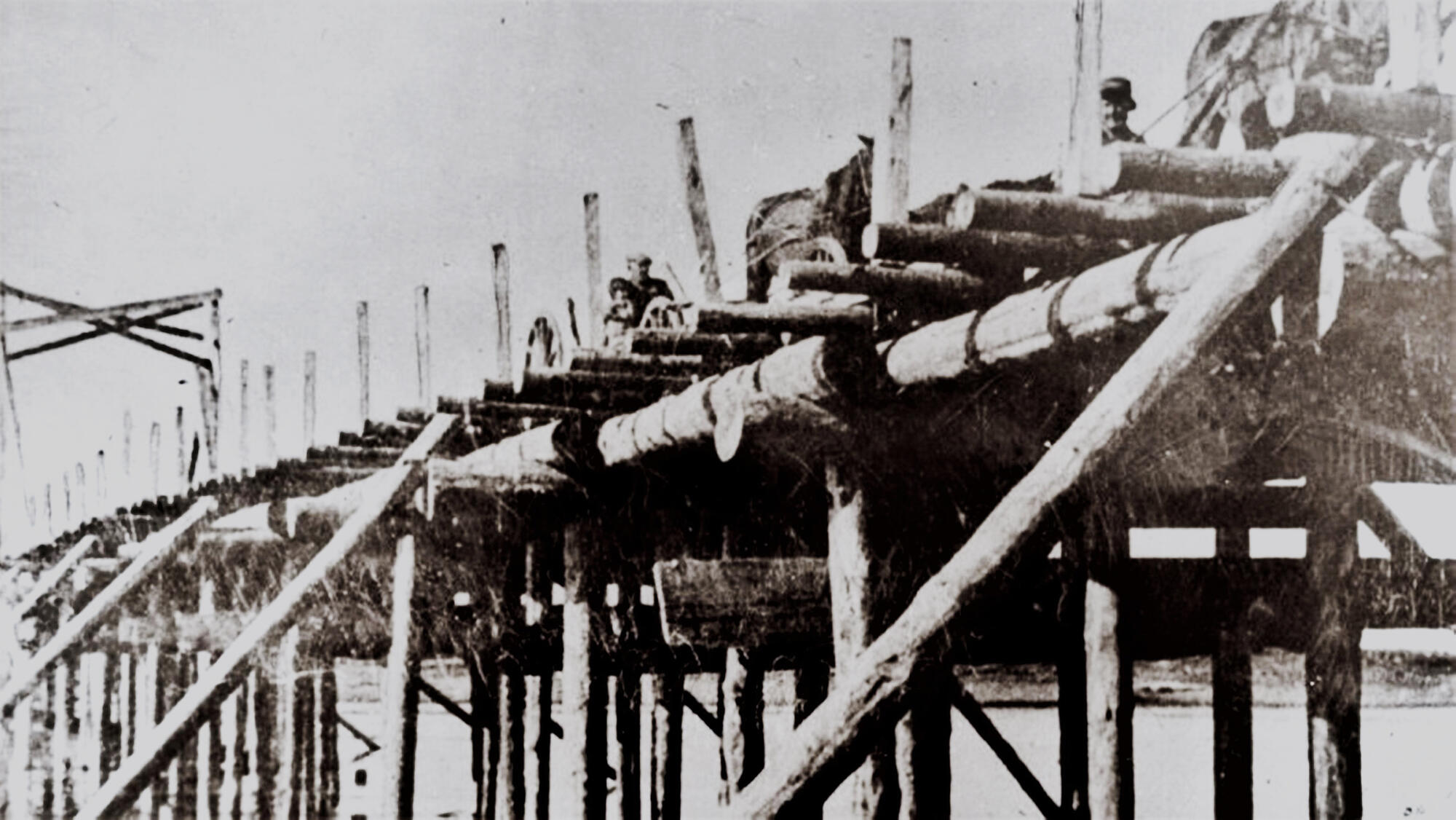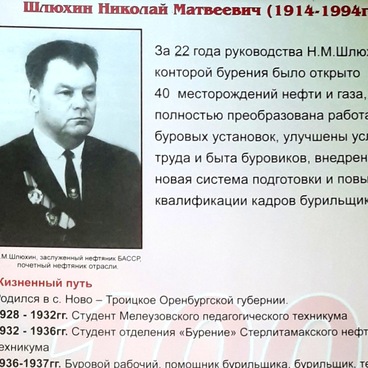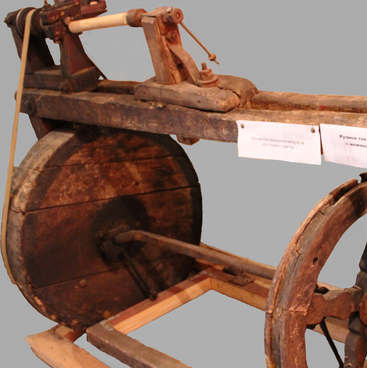In 1932, bore well No. 702, which is located on the right bank of the Belaya River, became the first Ishimbay well to produce commercial oil. Just a few days later, the first oil was obtained from another well, this time on the river’s left bank, nearby the village of Ishimbaevo. This made the need to connect the two banks with a bridge even more dire: even though the first crossing between the banks of the Belaya River was built back in spring 1930, it was swept away by floods the following spring, meaning that a new bridge had to be built in its place. This situation kept repeating itself until the construction of a heavy-duty bridge in 1950.
This photograph depicts one of the temporary wooden bridges across the Belaya River. Ishimbay’s residents were so tired of the yearly destruction and rebuilding of the bridge, that they complained about their persistent problem with transportation to Marshal of the Signal Corps Ivan Peresypkin first thing after nominating him for the State Council of the Soviet Union in 1946. PeresYpkin promised to help and sent an entire military unit to build a new bridge, finally putting an end to the problem in 1950.
In his book titled ‘Ishimbay. 21st Century, ’ Vladimir Ignatiev, founder of the Ishimbay Museum of History and Local Lore, recounts a curious story about the bridge’s construction. Allegedly, a young Ishimbay woman came to the Secretary of the City Committee Iskhak Yenikeyev complaining about her relationship with a soldier who was building the bridge. He wanted to stay and marry her, but all of a sudden the entire unit was ordered to relocate. The secretary was surprised, since the soldiers had yet to finish the construction. “I call the station master. He confirms: all equipment has already been loaded, they are leaving soon! It turns out, they had received an order to leave that day. We just barely managed to settle the matter, ” thus, claims Yenikeyev’s story, the construction was saved and the bridge was completed in 1950 after all.
Without a doubt, Marshal Peresypkin rendered an invaluable service to Ishimbay’s residents, however he is better known for his military achievements. On July 22, 1941, a month after the start of the Great Patriotic War, he was appointed chief of the Main Communication Directorate of the Red Army. As a result of the Hitler’s offensive, up to 60 percent of telegraph and telephone lines and up to 40 percent of communication equipment were lost. However, under Peresypkin’s leadership, the Red Army’s communications control system was completely rebuilt. Just a few months later, during the Battle for Moscow, signalers under his command laid a special communications ring around the capital, allowing the troops to bypass the central nodes and maintain better contact.
Peresypkin also made major efforts to establish field post offices, which handled about 100 million mailing units weekly. On multiple occasions, he personally conducted command visits, on which he monitored and greatly assisted the reorganization of field communication work in accordance with updated time sheets. As Commander of Signal Corps and the People’s Commissar of Signal Corps, he took effective measures to launch the production of new equipment and encouraged design mindset, thus making it possible to develop communications equipment that surpassed many contemporary models, including foreign ones. Signal Corps under Peresypkin’s command greatly contributed to the Victory.
This photograph depicts one of the temporary wooden bridges across the Belaya River. Ishimbay’s residents were so tired of the yearly destruction and rebuilding of the bridge, that they complained about their persistent problem with transportation to Marshal of the Signal Corps Ivan Peresypkin first thing after nominating him for the State Council of the Soviet Union in 1946. PeresYpkin promised to help and sent an entire military unit to build a new bridge, finally putting an end to the problem in 1950.
In his book titled ‘Ishimbay. 21st Century, ’ Vladimir Ignatiev, founder of the Ishimbay Museum of History and Local Lore, recounts a curious story about the bridge’s construction. Allegedly, a young Ishimbay woman came to the Secretary of the City Committee Iskhak Yenikeyev complaining about her relationship with a soldier who was building the bridge. He wanted to stay and marry her, but all of a sudden the entire unit was ordered to relocate. The secretary was surprised, since the soldiers had yet to finish the construction. “I call the station master. He confirms: all equipment has already been loaded, they are leaving soon! It turns out, they had received an order to leave that day. We just barely managed to settle the matter, ” thus, claims Yenikeyev’s story, the construction was saved and the bridge was completed in 1950 after all.
Without a doubt, Marshal Peresypkin rendered an invaluable service to Ishimbay’s residents, however he is better known for his military achievements. On July 22, 1941, a month after the start of the Great Patriotic War, he was appointed chief of the Main Communication Directorate of the Red Army. As a result of the Hitler’s offensive, up to 60 percent of telegraph and telephone lines and up to 40 percent of communication equipment were lost. However, under Peresypkin’s leadership, the Red Army’s communications control system was completely rebuilt. Just a few months later, during the Battle for Moscow, signalers under his command laid a special communications ring around the capital, allowing the troops to bypass the central nodes and maintain better contact.
Peresypkin also made major efforts to establish field post offices, which handled about 100 million mailing units weekly. On multiple occasions, he personally conducted command visits, on which he monitored and greatly assisted the reorganization of field communication work in accordance with updated time sheets. As Commander of Signal Corps and the People’s Commissar of Signal Corps, he took effective measures to launch the production of new equipment and encouraged design mindset, thus making it possible to develop communications equipment that surpassed many contemporary models, including foreign ones. Signal Corps under Peresypkin’s command greatly contributed to the Victory.



